Employee advocacy is when your team shares company content or messages on their personal social media.
And it’s more powerful than ever: as audiences continue to lose trust in brands, letting employees tell the story brings authenticity (and reach) no ad can buy.
Read on to hear what’s driving results this year and how to make employee advocacy actually work, powered by fresh Hootsuite Amplify data.
Key Takeaways
- Employee advocacy is when your team shares company content or messages on their personal social channels to boost your brand’s visibility and credibility.
- Employee advocacy builds stronger trust, engagement, and reach than traditional marketing.
- Benefits of employee advocacy include increased brand visibility, stronger trust and credibility, better recruitment, and a more connected company culture.
- Measure success by tracking participation, engagement, and ROI. With Amplify, you can see shares, reach, and conversions in one dashboard.
How does employee advocacy work?
Employee advocacy works by turning your people into trusted voices for your brand.
Most of the time, that happens on LinkedIn. But it’s also expanding to platforms like X, TikTok, and even Slack communities.
It can be as simple as employees resharing company content — like blog posts, product updates, or event highlights — or as involved as creating their own posts that showcase your brand’s values and culture.
How is employee advocacy different from influencer marketing?
Influencer marketing is about partnering with creators to talk about your brand. Employee advocacy is about empowering your people to tell it themselves.
One is paid reach, the other is genuine belief in what they do. That’s what makes it so authentic.
How is employee advocacy different from brand advocacy?
Brand advocacy usually comes from your customers – people who love your product and chat about it online.
Employee advocacy, on the other hand, happens inside your org. It’s your team sharing their work, values, and wins.
Both matter, but employee advocacy gives you a lot more consistency and control.
What makes employee advocacy more effective than brand channels?
In 2025, audiences trust people a lot more than logos. In fact, a recent study found that 60% of consumers trust what individuals say about a brand more than what the brand says about itself.
So, when your employees speak, people pay attention.
Social algorithms know this, too. Posts from personal profiles get prioritized in feeds, which means employee-shared content often travels farther than anything from a brand page.
In short: when your employees show up online, your brand becomes a lot harder to ignore.
At Hootsuite, we’ve seen this firsthand:
Data from Hootsuite’s Employee Advocacy Program (2024 – 2025)
Our own team uses Amplify to share content every single week – from thought leadership to industry news and company announcements.
Here are some results to help put your own employee advocacy program performance into perspective:
| Metric | Result |
| Active users | 40–50% of Hootsuite employees |
| Average posts shared per employee | 1.2 per week |
| Average reach per post | 21,920 |
| Average shares per post | 8.8 |
| Top-performing post reach | 207,786 |
| Top-performing post shares | 115 |
What are the benefits of employee advocacy?
Here’s how employee advocacy helps your organization grow:
- Increases reach and brand visibility. Employee-shared content gets in front of new audiences and makes your brand impossible to scroll past.
- Builds trust. A brand backed by real people feels more human and credible.
- Attracts and retains talent. Employees give job seekers an authentic look at your culture while keeping current employees more engaged.
- Strengthens company culture. Advocacy brings people together, builds belonging, and turns employees into culture ambassadors.
How does employee advocacy increase reach and brand visibility?
When employees share content, they introduce your brand to an entirely new audience you wouldn’t reach on your own.
And here’s the wild part: employee networks are, on average, 10x larger than their company’s follower base. Yep, ten times.
That’s like giving your brand a megaphone in every employee’s feed.
IT solutions provider Carahsoft saw this in real time after launching Hootsuite Amplify.
When employees started sharing partner and event content, reach exploded. We’re talking 8,700 new website visits and 35% of event registrations from employee posts alone.
This is proof that when you hand the mic to your people, your message can travel further.
Why do employees build more trust than branded accounts?
Employees build more trust than branded accounts because they show up as real people, not marketing messages.
When an employee shares something genuinely insightful or relatable, it doesn’t read like another corporate post. And it doesn’t feel like marketing, either.
Instead, it comes across as a real conversation.
That’s exactly what Athletico Physical Therapy found when they empowered their team of therapists, athletic trainers, and recruiters to share their own stories online.
To keep things running smoothly, the team planned content around key moments (like National Physical Therapy Month) when engagement was already high. They also made it easy for their people to share brand content directly through the Amplify dashboard.
As a result, Athletico built stronger connections with their communities, boosting engagement and growing reach by 40%.
How can advocacy help with recruitment and employer branding?
Employee advocacy helps attract top talent by giving potential hires a real look at your culture, way beyond your careers page.
In fact, companies with socially engaged employees are 58% more likely to attract top talent.
When employees share their experiences online, it paints a more authentic picture of your culture. It’s the kind of content that makes people think, “Hmm, I could see myself there.”
DaVita, a global healthcare company, uses employee advocacy to attract top talent.
Their recruitment and social teams teamed up to empower employees to share their experiences at DaVita — what it was like to work there, how they grew, and why it mattered. Using Hootsuite Amplify, employees could easily post approved stories that highlighted their work.
And it worked.
DaVita saw a 136% increase in LinkedIn traffic to its careers page and a 27% lift in job applications from social.
Can employee advocacy strengthen company culture?
Employee advocacy can absolutely strengthen company culture.
When people feel proud of their work — and trusted to share it — it turns them into culture ambassadors. It builds pride, connection, and belonging, and shows the world what your culture actually looks like in action.
What types of content work best for employee advocacy?
LinkedIn is overrun with polished posts, which is why authenticity wins.
It’s also why Eileen Kwok, Social & Influencer Marketing Strategist at Hootsuite (and leader of Hootsuite’s own Employee Advocacy Program), leans toward content that feels real and personal.
“Real experiences, expert insights, and innovative marketing approaches are the types of stories people want to see more of on LinkedIn,” she shares.
And when it comes to format, simple works best.
“I believe users still naturally gravitate towards what LinkedIn was originally known for, which leaned primarily into either text or image posts,” Eileen says.
However, there’s a good chance your employees have their own preferences too. Giving them the freedom to share what feels natural helps them feel confident hitting “post,” and keeps their engagement authentic. If you can, keep editing permissions flexible to enable employees to customize their posts in a tool like Hootsuite Amplify.
Should employees share brand content or create their own?
Both work, but it’s most effective when employees put their own spin on brand content.
Eileen recommends starting with ready-to-share posts from your brand (like those in Hootsuite Amplify), then giving employees room to make them personal.
“To make Amplify content feel more personal, focus on small but meaningful adjustments. Write copy in the first person, give team members opportunities to customize their posts, and avoid overly rigid branding or logo-heavy visuals,” she says.
Those small tweaks let people show up in their own voice, not through a corporate megaphone.
“Once employees feel more confident sharing, you can continue to encourage deeper personalization in their content,” Eileen adds.
Can employees share external or third-party content?
Absolutely, and they should.
Sharing industry news, insights, and thought leadership turns your people into trusted voices, not just brand messengers. Plus, it keeps their content balanced. Not every post should feel like a promo.
According to a study from DSMN8, top-performing employee advocacy programs source content from:
- 70% social media posts
- 66% company blogs
- 52% industry news
- 50% employee-generated content
- 32% podcast episodes
A healthy mix of brand, employee, and industry content helps employees build their personal brand and boost your company’s visibility.
How do you repurpose content for employee advocacy?
You don’t need to reinvent the wheel to keep your employee advocacy program running — just make use of what you already have.
Turn your top-performing social posts, blog content, and campaign assets into ready-to-share updates for your team. With a quick refresh (like swapping a CTA for a personal takeaway), they feel new again.
Hootsuite Amplify makes it even easier: it curates content from multiple sources (think: social posts, blogs, and videos) into one simple feed your employees can browse, personalize, and share.
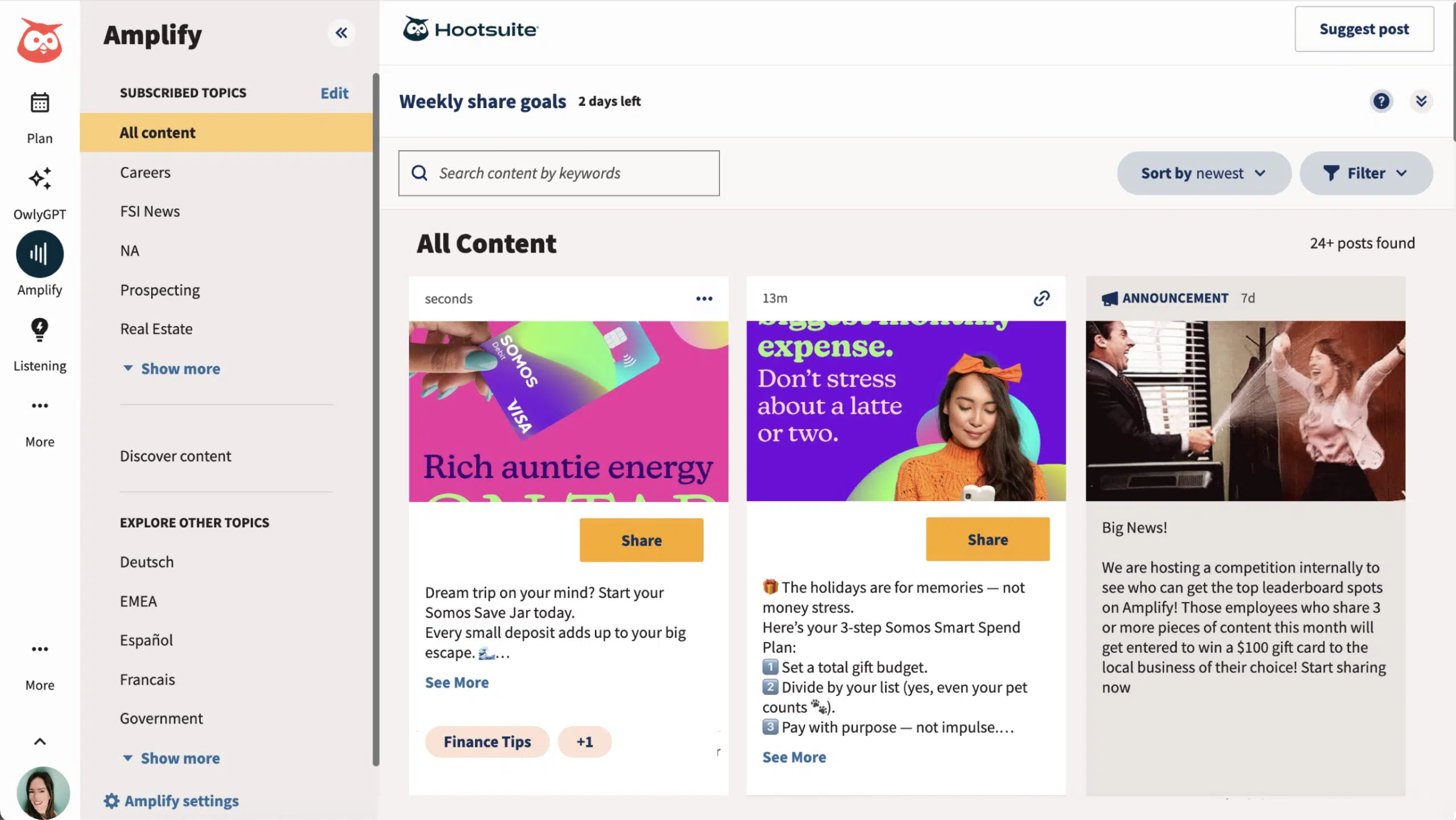
How do you start an employee advocacy program?
Like any great social strategy, success starts with buy-in. Get leadership on board early to show that advocacy is a real priority, not just a nice-to-have.
Then rally a small group of employees who are active (or excited to be) on social media. These early advocates will help shape your program, test what works, and lead by example.
Once you’ve got leadership support and a few passionate champions, you’re ready to build momentum and roll it out company-wide.
What steps are involved in launching an employee advocacy program?
Starting an employee advocacy program comes down to setting clear goals, creating share-worthy content, and making it easy for employees to participate.
Here’s what to do, step by step.
Step 1: Set goals.
Decide what you want to get out of your employee advocacy. Maybe you want to expand your brand’s reach, attract new talent, boost engagement, or all of the above. Setting clear goals will help you measure what’s working later.
Step 2: Identify your champions.
Employee advocacy works best when people actually want to be part of it. Look for your natural brand champions — the people who already post on social media and bring good energy online.
Start small with this group, then expand. When people see peers leading the way, they’re more likely to jump in too.
Step 3: Curate content employees (actually) want to share.
Those overly polished corporate posts that use words like “synergy” and “optimize”? Yeah, those won’t fly. People want real stories, not buzzwords.
Think about what would make someone proud to post. Content that spotlights your people, celebrates wins, and shows genuine behind-the-scenes moments always performs better than a polished press release.
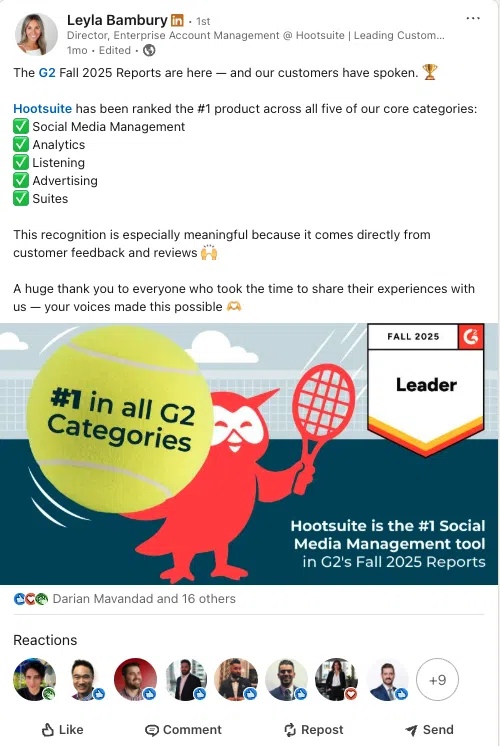
Step 4: Make sharing easy.
Starting an employee advocacy program isn’t about adding another task to everyone’s plate. The simpler it is to share, the more likely people are to join in.
This is where a platform, like Hootsuite Amplify, really comes into play. Employees can browse pre-approved posts, visuals, and links, then share to their own feeds in seconds.
And because Hootsuite Amplify connects with tools your teams already use — like Slack and Microsoft Teams — employees can also personalize and post content right from their daily workspace.
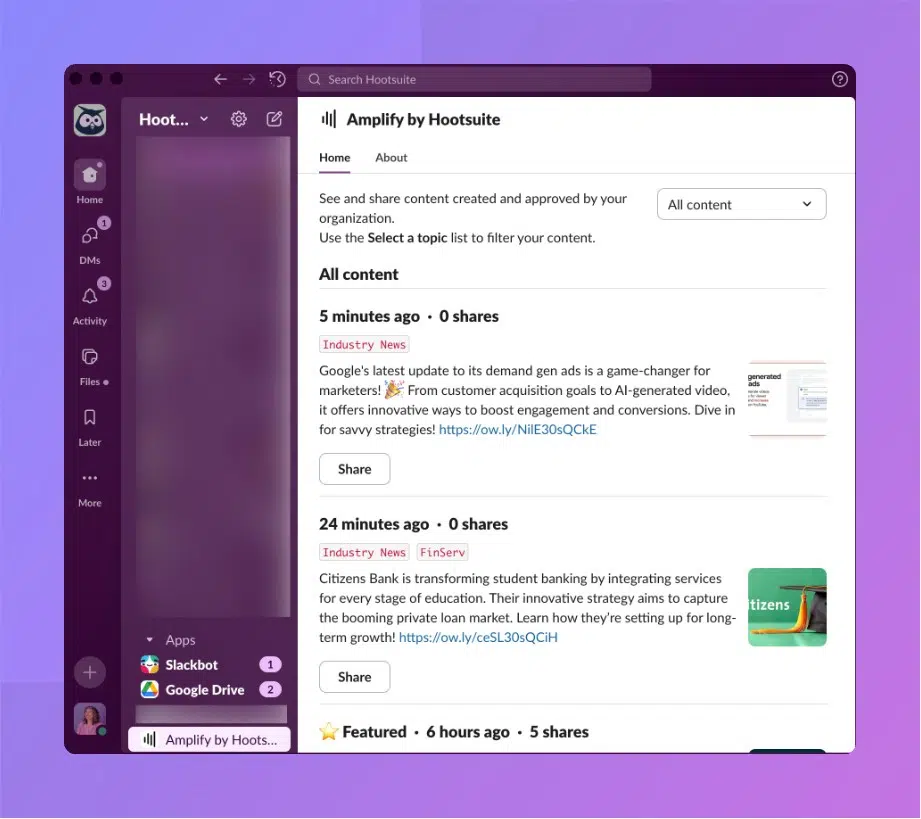
Step 5: Build momentum.
Host a kickoff session or quick demo to show employees how it works. Encourage everyone to share their first post in the same week to create some buzz.
As your program grows, use Amplify’s leaderboard to spotlight your most active advocates and spark a little friendly competition between teams.
You can even sweeten the deal by gifting a prize to the person or team who earns the most impressions or engagement over a set period of time.
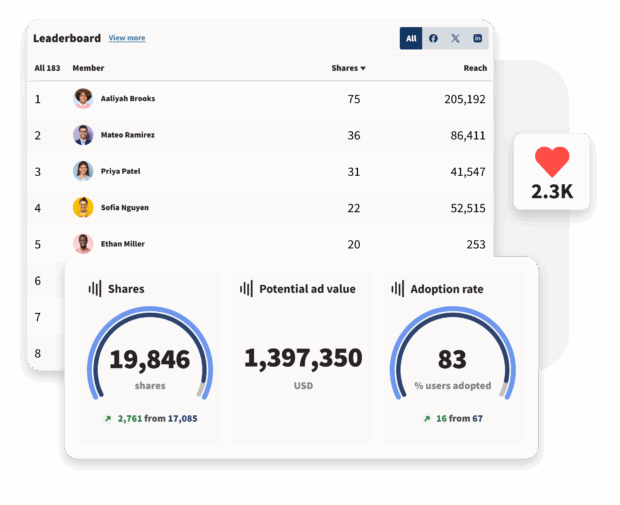
Step 6: Measure and grow.
Track participation and performance to see what resonates most. Then keep fine-tuning your approach.
Amplify makes it easy to spot your top sharers, see what content lands, and keep your program running like a well-oiled (and highly social) machine.
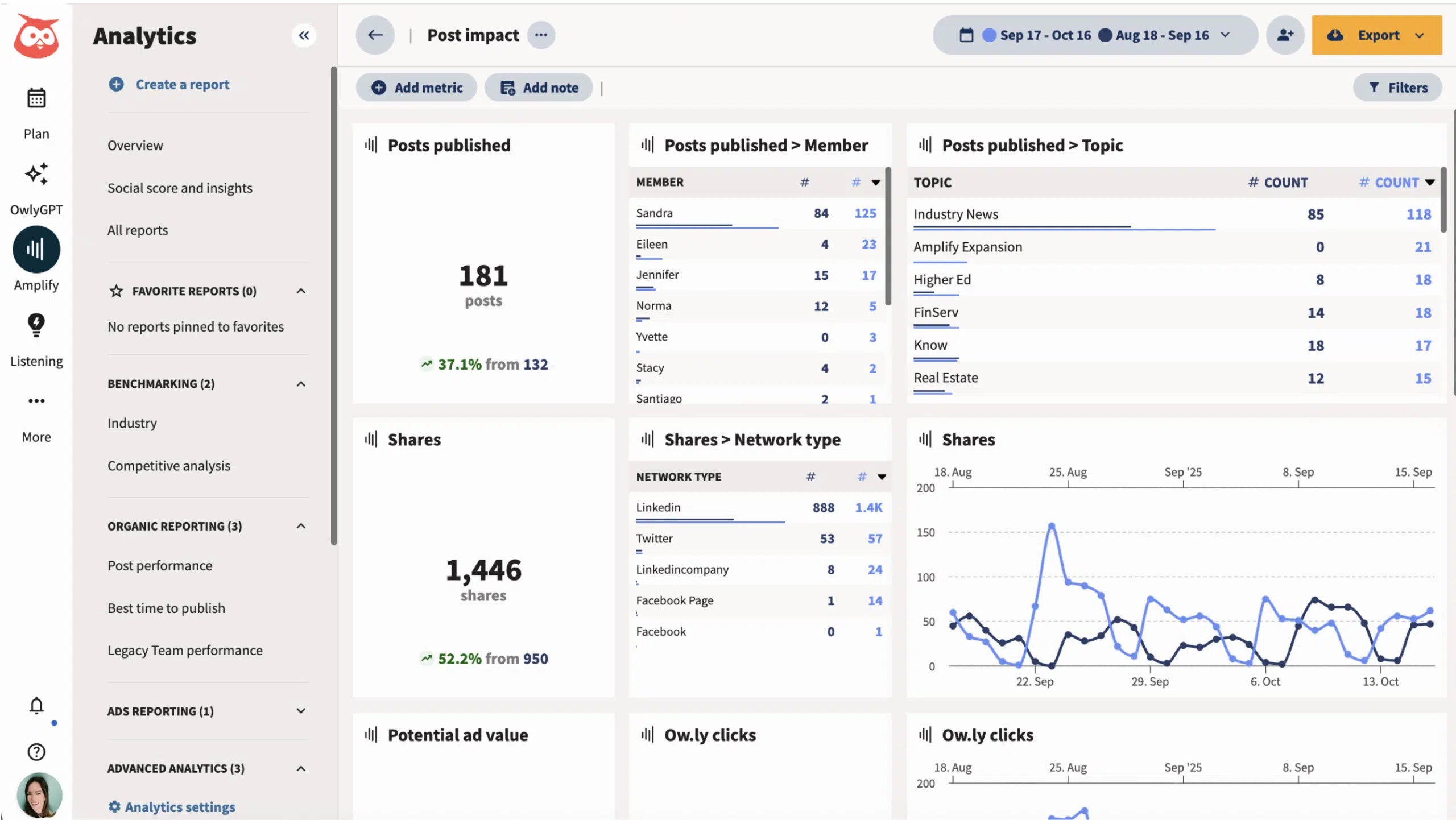
How do you motivate employees to participate?
To motivate employees to participate in advocacy, make it simple, rewarding, and part of their daily routine.
Eileen has a simple but effective habit:
I’ve found that encouraging employees to begin their workday by sharing a post through Amplify helps make it a natural part of their daily routine. As a best practice, I recommend aiming for everyone to share at least one post per week to build consistent engagement.
- Eileen Kwok, Social & Influencer Marketing Strategist, Hootsuite
The stats speak for themselves:
- Nearly half (40–50%) of Hootsuite’s workforce are active Amplify users
- On average, they share 1.2 posts per week
When advocacy feels natural, participation follows.
What guidelines should you set up to keep employee advocacy authentic and compliant?
To keep employee advocacy authentic and compliant, create clear guidelines so people know what’s safe to share.
This typically starts with a basic social media do’s and don’ts list. For example:
Do:
- Disclose your role with the company when it’s relevant.
- Keep things positive and aligned with company values.
Don’t:
- Share internal-only information, client details, or anything confidential.
- Copy and paste content word-for-word, make them your own.
To make posting even easier, give employees access to pre-approved content in Hootsuite Amplify. It takes the stress out of posting and helps everyone show up confidently online (no more second-guessing).
As your program grows, you may notice new needs pop up – like teams asking for extra help with storytelling or design.
That’s a good sign. It means your people want to level up. When that happens, consider offering a few extra resources to guide them, like:
- A personal branding guide
- A thought leadership guide
- A style guide for images and graphics
These tools help employees show up consistently and confidently while still keeping their authentic voice.
What tools can help scale an advocacy program?
Between managing content, scheduling posts, and tracking who’s actually sharing, things can get messy fast
Look for a platform that helps you centralize content, automate scheduling, and measure participation all in one place. Tools like Hootsuite Amplify make it easy to manage all those moving parts so your program can scale without the growing pains.
How do you measure employee advocacy success?
Before you can measure success, you need to know what you want to get out of your program.
Maybe it’s growing your brand’s reach. Maybe it’s attracting new talent. Or maybe it’s building a stronger culture. Whatever your goals are, they’ll shape how you measure progress.
The key is to tie your advocacy efforts back to real business impact. Are more people discovering your brand? Are better candidates applying? Are employees more engaged?
Once you’re clear on that, it’s time to dig into the numbers that tell the story.
What KPIs show employee advocacy is working?
The best employee advocacy programs track a mix of participation and impact. Together, they show who’s getting involved and what results it’s driving across your org.
Here’s what to keep an eye on:
Participation metrics:
- Number of active participants
- Posts shared per employee
- Overall adoption rate (how many people are using your advocacy tool)
Engagement metrics:
- Impressions, clicks, and reactions on shared posts
- Increases in followers, mentions, or reach
- Traffic or conversions driven by employee-shared links
Recruitment metrics
- Traffic to your careers page from employee-shared posts
- Applications that can be traced back to advocacy content
- Time-to-hire before and after launching your advocacy program.
Culture metrics
- Pulse surveys to measure engagement and belonging
- Participation and retention rates in your advocacy program
What is the ROI of employee advocacy? And how can I track it?
The ROI of employee advocacy comes from three main areas: increased brand reach, stronger trust, and reduced ad spend.
To track that ROI, focus on metrics that connect advocacy activity to business impact, such as:
- Earned media value (EMV): the estimated cost you’d pay to get the same reach through paid media.
- Traffic and conversions: how much employee-shared content drives visits, signups, or leads.
- Recruitment metrics: referrals, applicants, or hires influenced by advocacy.
- Engagement lift: how employee posts perform vs. branded posts in reach and interactions.
You can even plug your numbers into the Hootsuite Employee Advocacy ROI Calculator to see the dollar value of your advocacy program.
And with Hootsuite Amplify, you can track performance in real time — from top-performing advocates to total shares, reach, and conversions. You can even see how much reach you’re earning compared to paid campaigns, all without exporting a single spreadsheet.
Employee advocacy FAQs
How does employee advocacy fit into a broader social strategy?
Employee advocacy complements your existing social strategy by adding a layer of authenticity you can’t get from paid channels alone.
Your brand channel builds awareness. Paid campaigns drive visibility. Employee advocacy adds credibility.
Together, they create a balanced social strategy that reaches more people and earns their trust.
What makes employee advocacy more effective than traditional brand marketing?
Traditional brand content can only go so far. When employees share, audiences see real voices and real stories, and that’s what drives more reach and engagement than paid campaigns ever could.
What teams should be involved in launching an employee advocacy program?
Marketing usually leads the charge, but HR and leadership should all play a role. Marketing provides the content and strategy, HR brings in recruitment and engagement goals, and leaders help build momentum by setting the example.
How can employee advocacy support recruitment marketing and employer branding?
Employee posts give job seekers a real look at your culture and values. It’s authentic social proof that builds trust long before anyone visits your careers page.
How do I prove the ROI of employee advocacy to leadership?
To prove the ROI of employee advocacy, start by connecting your advocacy goals to business results. Track how employee-shared content drives reach, engagement, traffic, and even conversions. Then layer in metrics that show impact across recruitment, retention, and culture.
Tools like Hootsuite Amplify make it simple to track everything in one place, so you can show exactly how advocacy moves the needle.
Start a winning employee advocacy program at your company with Hootsuite Amplify. Curate engaging content, customize permissions, reward top sharers, and track the business impact — all in one, easy-to-use dashboard. Try it today.
The post Why employee advocacy matters in 2025 + what actually works appeared first on Social Media Marketing & Management Dashboard.




It’s interesting how much employee advocacy can reshape a brand’s narrative. I’ve seen it firsthand in my own workplace; when our team shares personal stories related to our projects, it makes a huge difference in how the audience perceives us. Authenticity really resonates in today’s world, where so many prefer relatable experiences over polished corporate messages.